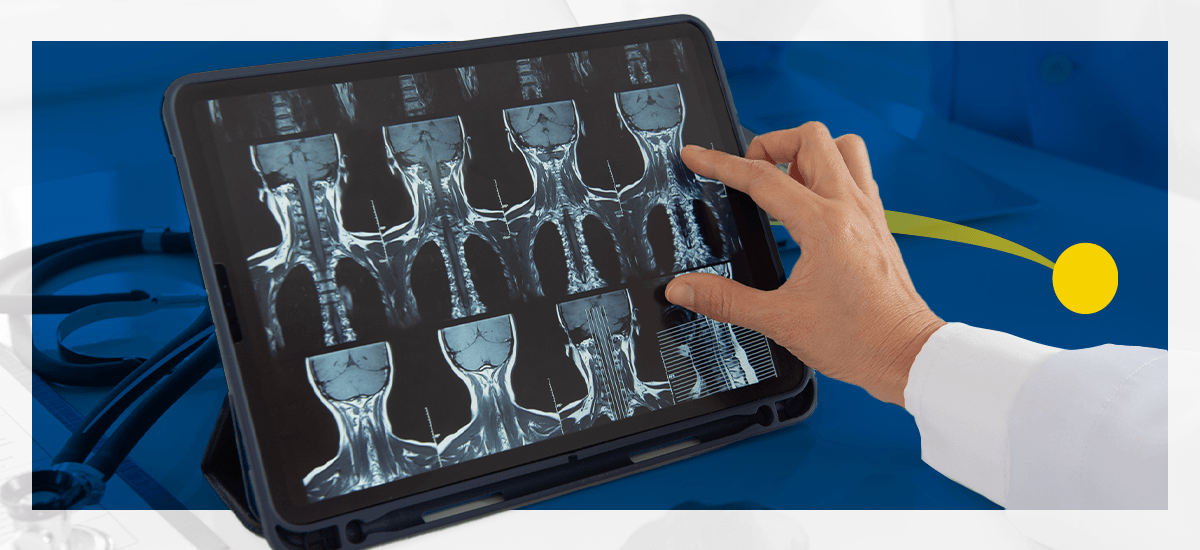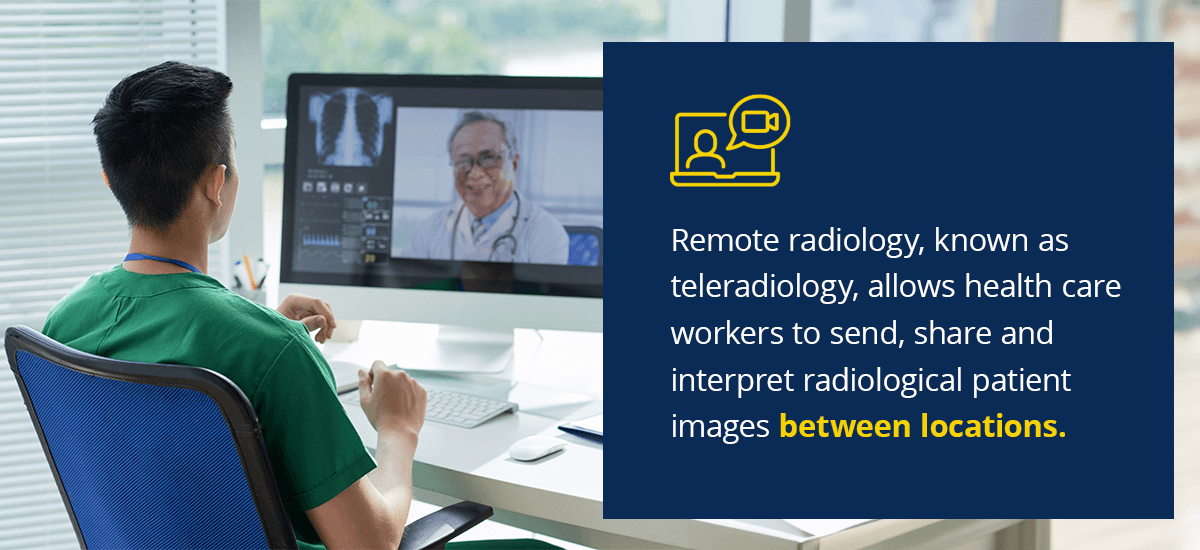Teleradiology — Can Radiologists Work From Home?

The radiology field is evolving, ushering in the exciting possibility of remote work. If you've ever daydreamed about trading your daily commute for a home office, read on to explore the growing trend of teleradiology, its benefits, challenges and what it takes to become a remote radiologist.
What Is a Remote Radiologist?
Remote radiology, known as teleradiology, allows health care workers to send, share and interpret radiological patient images between locations.
The concept is not new. Its roots date back to the 1940s, when professionals transmitted images via telephone lines. However, the field has exploded with high-speed internet, advanced imaging technologies and secure data transmission protocols. Today, teleradiology is a crucial component of modern health care, enabling rapid diagnosis and treatment for patients worldwide.
Necessity of Teleradiology
Teleradiology has become increasingly necessary in recent years for the following reasons.
- Access to expertise: Teleradiology allows smaller hospitals and rural areas to access subspecialty radiologists who might not be available locally.
- 24/7 coverage: It enables round-the-clock radiology services, which are crucial for emergency departments and urgent care centers.
- Reduced turnaround time: Radiologists working across different time zones can interpret images quickly, leading to faster diagnoses and treatment.
- Cost-effectiveness: Health care facilities can reduce overhead costs associated with maintaining an on-site radiology department.
- Workload balancing: Teleradiologists distribute their workload more evenly, improving efficiency.

How to Become a Remote Radiologist
Becoming a remote radiologist requires the same rigorous education and training as traditional on-site radiologists, including:
- Completing a bachelor's degree
- Graduating from medical school
- Completing a residency in radiology
- Obtaining a state medical license
- Passing board certification exams
Additionally, remote radiologists must have excellent communication skills and be comfortable working independently. Familiarity with teleradiology software and picture archiving and communication system is also crucial.
Do Remote Radiologists Make as Much as On-Site Radiologists?
One of the most prevalent questions about teleradiology is whether it's financially viable. Do radiologists work from home for the same pay as their on-site counterparts?
On average, remote radiologists earn competitive salaries. According to recent data from ZipRecruiter, the average remote radiologist salary in the United States ranges from $300,000 to $400,000 annually, comparable to on-site radiologists.
However, salaries can vary based on factors such as experience, workload, subspecialty and the specific teleradiology company or health care system. Some remote radiologists may earn less than their on-site counterparts due to reduced overhead costs for employers. Conversely, others might earn more due to the ability to take on additional shifts or work for multiple facilities.
Remote radiologists perform the same core tasks as on-site radiologists — interpreting medical images, writing reports and consulting with other physicians. The distinction lies in the communication methods and technology used to view and analyze images.
Remote radiologists often have opportunities for salary increases, especially as they gain experience and subspecialize. Many teleradiology companies offer competitive benefits packages, including health insurance, retirement plans and continuing education allowances. Some even provide technology stipends to ensure radiologists have top-notch equipment for their home offices.
Pros of Teleradiology
Teleradiology offers numerous advantages for radiologists considering a remote career.
Flexibility and Work-Life Balance
Flexibility is one of virtual radiology's most significant benefits. Remote radiologists are often free to set their schedules, allowing for a better work-life balance. They also do not need to commute to a specific hospital location, meaning they can live wherever they choose.
For instance, a radiologist with young children might choose to work early mornings and evenings, freeing up daytime hours for family activities. Another might prefer to work intensively for a few days and then take several days off. Controlling your schedule can increase job satisfaction and reduce stress.
Enhanced Efficiency
Without the distraction of a hospital environment, you may find you can work more efficiently from home. A quiet, personalized workspace can lead to better focus, increased comfort and faster turnaround times.
Diverse Experience
Working with multiple facilities can expose you to a broad range of cases, enhancing your skills and experience. This diversity can particularly benefit radiologists looking to specialize or expand their expertise.
Needing to stay abreast of technology also ensures remote radiologists continue growing their knowledge. This commitment to continued learning means you can get hired for more specialized jobs and further diversify your experience.
Improved Quality of Life
Working from home means no daily commute, saving time, reducing transportation costs and eliminating the stress associated with traffic. Remote radiologists can also create an ergonomic workspace that ensures proper posture and better physical health.
Remote work gives teleradiologists more time to prepare healthy meals, exercise, pursue hobbies and spend time with family, friends and pets. Enriching your personal life makes you less prone to stress and burnout.
Cons of Teleradiology
While teleradiology has numerous benefits, you should consider the potential drawbacks.
Professional Isolation
Remote radiologists may miss out on face-to-face interactions with patients and colleagues, leading to feelings of disconnection from the broader medical community.
Fewer in-person interactions may limit your professional networking and career advancement opportunities. Building relationships and staying visible within your field can be more challenging when working remotely.
Licensing Challenges
While remote radiologists have the advantage of working for various facilities, doing so may raise the challenge of obtaining licenses from multiple states — a complex and costly process that can impact your finances and work morale.
Many teleradiology companies assist with licensing requirements, but you should prepare for the initial investment and the continuing cost of maintaining your license.
Technology Costs
Teleradiology relies heavily on technology, which can present additional challenges. For example, you'll need to invest in high-resolution monitors, powerful computers and reliable high-speed internet for your home office.
Additionally, technical issues can be stressful and disruptive, impacting patient care if not quickly resolved. For teleradiologists paid per hour, this can cause them to lose money.
Work-Life Balance Paradox
While teleradiology can improve work-life balance, it can also paradoxically lead to difficulty separating work from personal life. Some remote employees struggle to "switch off" without a clear separation between work and home. The ability to work anytime can lead to longer hours and difficulty disconnecting from your job responsibilities.
Working from home requires strong self-motivation and discipline to maintain productivity. Without the structure of a traditional workplace, some radiologists may find it challenging to stay focused and manage their time effectively.
Cloud Imaging Solutions From Candelis
Teleradiology offers a viable and increasingly popular career path for radiologists. It provides flexibility, competitive salaries and the opportunity to serve a broader patient base. While it comes with challenges, many find the benefits outweigh the drawbacks. As the field evolves, cloud imaging solutions enable efficient and secure remote radiology practices.
At Candelis, we're at the forefront of this revolution. Our cutting-edge PACS and cloud imaging solutions seamlessly integrate with your existing systems, enhancing efficiency and security in remote radiology practices.
Contact us today to learn more about our imaging solutions or book a free demo.
- Log in to post comments

